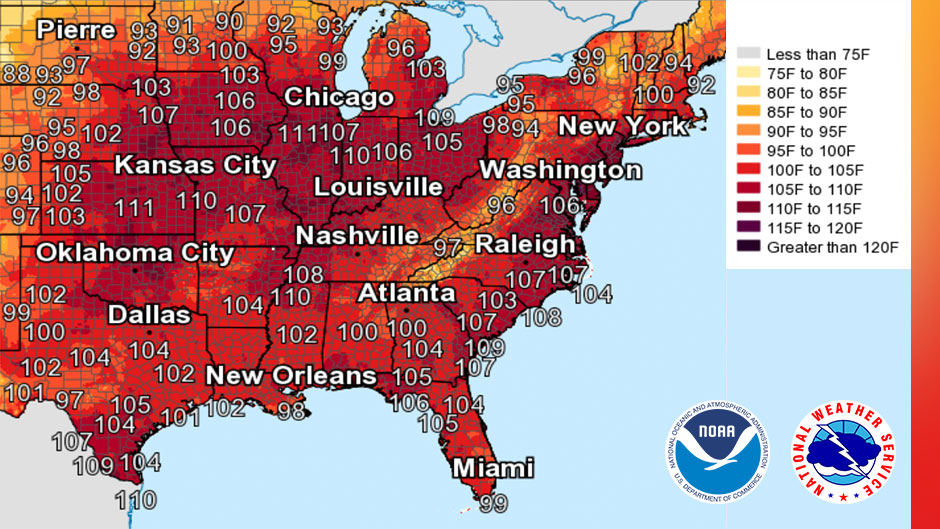The dangerous heat wave building across the central and eastern U.S. today is setting the stage for what the National Weather Service predicts will be a “miserably hot and humid weekend for millions of Americans.”
Unfortunately, the searing temperatures that are expected to shatter dozens of record-high low temperatures and set a number of record-high maximum temperatures in two-thirds of the country are also likely to lead to a number of deaths, particularly of the elderly. After all, extreme heat has been the leading weather-related cause of death for the past 30 years. Not flash floods, tornadoes, lightening, or rip currents, but heat, which claimed 108 lives in the U.S. last year. (Floods killed 80 people.)

Not long ago, that surprised Hosmay Lopez, the lead author of a 2018 study, published in Nature Climate Change, on the emergence of human-induced heat waves in the western U.S. and Great Lakes regions. Lopez, a meteorologist with the NOAA Cooperative Institute for Marine and Atmospheric Studies at the University of Miami Rosenstiel School of Marine and Atmospheric Science, said the fact that extreme heat is the No. 1 weather-related killer wasn’t common knowledge even in the weather and climate community. He speculated that’s because heat waves were perceived as boring “weather-stagnant phenomenon” and didn't get much attention.
But he’s certain that will change as the planet continues warming. Here he explains why.
High temperatures are expected in July, but heat waves are becoming more common, intense, and longer lasting. Is that definitely related to climate change?
Indeed, heat waves are becoming more common and are projected to continue increasing in the future due to anthropogenic (human-induced) climate change. We have good reliable temperature records for the U.S. dating back to the 1800s. From those, we can conclude that the frequency of heat extremes relative to cold extremes has been steadily increasing since the 1960s. In fact, right now, there are more than twice the heat extremes than cold extremes in the U.S.
So is this the new normal? Can we expect more life-threatening heat waves in the future?
I am afraid that this is not the new norm. In fact, these events are going to become even more common. This is because we have not accomplished our promised reduction in greenhouse gasses and the planet is still in a warming trend. One thing that is often overlooked and was highlighted in our 2018 study is the fact that if we get a 1-degree temperature rise, that does not necessarily translate into a heat wave that is 1 degree warmer than a previous heat wave.
For some places, this increase will be much more than the average temperature rise. This is due to the way our climate system is linked. Here’s an example: The warmer it gets, the more water is evaporated from the soil. The dryer the soil, the warmer the air above it gets. And the loop continues.
This is your classic heat island effect, where lack of vegetation and thus soil moisture leads to an increase in air temperature, compared to nearby places with more vegetation. But during heat waves, this heat island stretches for hundreds of miles and could persist for weeks.
How many more heat waves can we expect, and where?
Our 2018 study showed that the most dramatic increase will occur over the western U.S. and the Northeast and Great Lakes regions. We specifically found that by the late 2020s and 2030s, human-induced climate change will be responsible for at least half of the occurring heat waves over the western and Great Lakes regions. That is, half of the heat waves would not have occurred in the absence of human-induced climate change. This is in contrast with regions such as the Central Great Plains, where naturally occurring heat waves will dominate up until the 2070s. After that, human causes will dominate.
Why does high humidity, which is reflected in the soaring heat index, exacerbate heat waves?
We humans don’t actually feel temperature; what we feel is apparent temperature, which includes relative humidity. When high temperatures are present, the body reaction is to sweat. As sweat evaporates from our skin to the surrounding air, our bodies cool down, just as the soil moisture cools the air when it evaporates. But the rate of evaporation decreases as moisture in the surrounding layer of air increases.
Thus, the mechanism whereby our bodies cool becomes less and less efficient as moisture increases. This could lead to overheating and even death. Another exacerbating effect during heat waves is the lack of wind. Little or no wind also will reduce the rate of evaporation, as well as the rate at which our body loses heat to the surrounding air, causing overheating as well. So, a combination of high temperatures, high humidity, and low winds are detrimental for human health.
Do most people who die during heat waves succumb to overheating?
Most of the deaths from heat waves are attributed to respiratory complications due to existing health conditions rather than direct heat strokes, for example. One of the most dangerous aspects of heat waves is the reduced air quality for prolonged periods of time, sometimes lasting for weeks to a month. This is caused by the same stagnant weather patterns that give rise to the extreme temperature itself as well as by the increase in forest fires due to extreme heat and drought. One way to visualize this is that the pollutants that are mostly present in the atmosphere near the ground (i.e., from the ground to up to a few hundred feet) do not mix with the cleaner air above due to reduced winds, causing a build up of pollutants and thus reduced air quality.
Floridians are used to stifling heat, but do you see a time where scorching temperatures will make the state virtually uninhabitable?
The rise in temperature should be one of the least concerns for Floridians regarding climate change. We should be more concerned about sea-level rise as it is one of the more immediate manifestations of climate change in our area. The rate at which temperatures are increasing in Florida is slower than other regions in the U.S.
In fact, Florida is not known for being historically impacted by heat waves and this is not because, as some say, “We live in an eternal heat wave,” which we don’t. For example, Miami has only seen one 100-degree Fahrenheit day in the temperature records. This is observed, for example, dozens of times every summer in Houston and Dallas. With that said, extreme heat should not be taken lightly anywhere.

